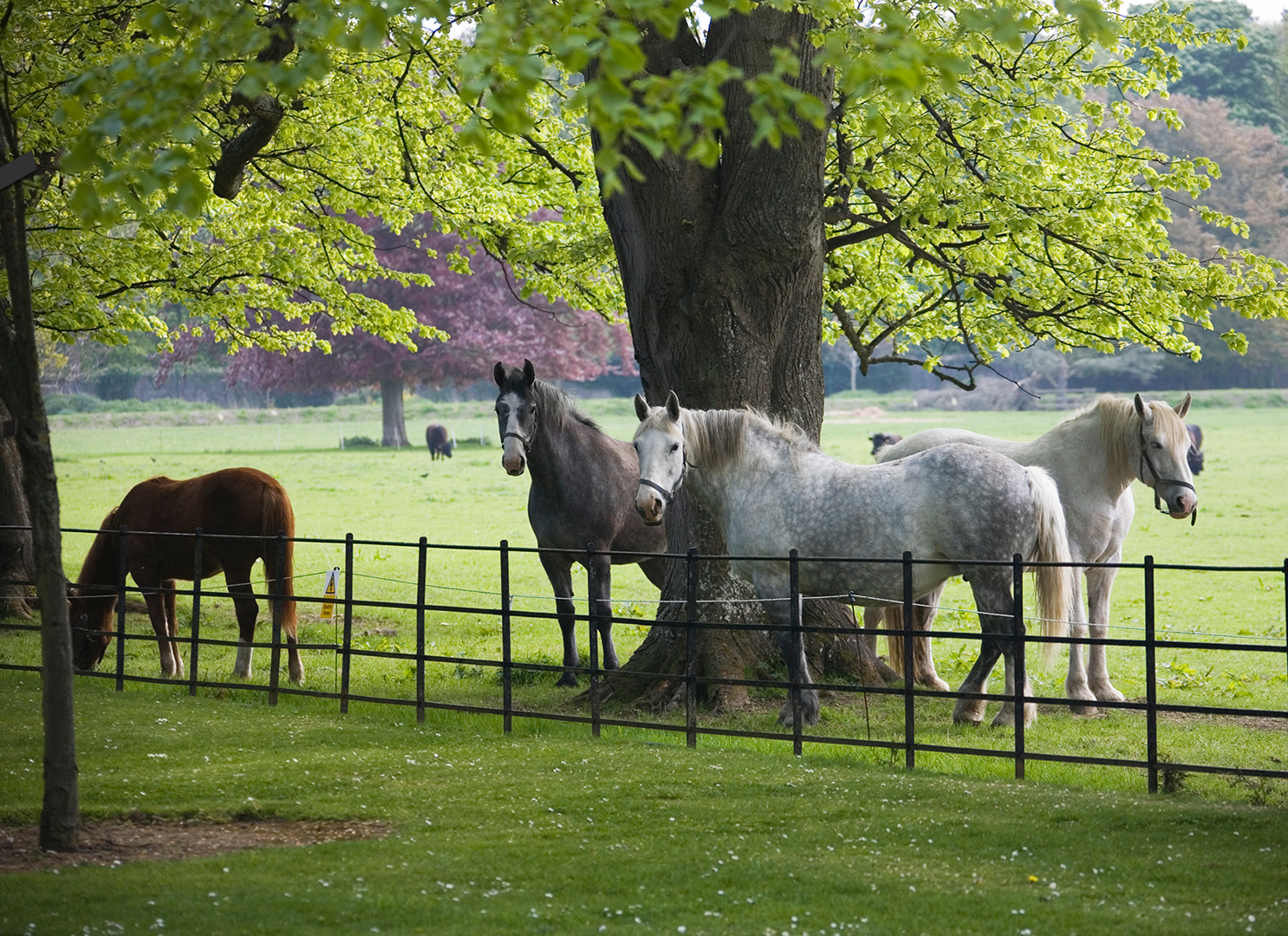Farmleigh has an estate of seventy-eight acres.
Outside of the house and pleasure gardens, Farmleigh estate hosts horses, donkeys, sheep and cows. All of the animals are cared for by the Office of Public Works and live at Farmleigh all year round. Farmleigh has had many horses over the years; the current horses are Ellie and Tyrone. The four donkeys all came from The Donkey Sanctuary in Cork, and are named Daragh, Ronnie, Barney, and Rosie. They are all about fifteen years of age, and love their home at Farmleigh.
- Donkeys at Farmleigh. OPW
- Donkeys at Farmleigh. OPW
- Donkeys at Farmleigh. OPW
- Horses at Farmleigh. OPW
- Horses at Farmleigh. OPW
- Horses at Farmleigh in May 2016. OPW
The Kerry Cow at Farmleigh
For many years Farmleigh was synonymous with the Charolais breed of cattle. When the State took ownership of Farmleigh, the tradition of keeping cattle there was continued, and it was agreed that the Kerry Cow, a native breed, would be ideal. The Kerry is widely recognised as Ireland’s unique native cattle breed. It is one of the oldest breeds in Europe, and it was dominant in Ireland up to about the end of the eighteenth century. In the 1980s, the breed was threatened with extinction. It represents part of our cultural heritage, and over the centuries it is the product of human and natural selection under difficult and demanding environmental conditions. The Kerry is a breed unto itself, a breed that has seen the Irish farmer through hard times. It has the ability to live on marginalised land, to calve without trouble, and to winter outdoors happily.
A survey conducted in 1998 stated that there were 135 breeds in Ireland, 22 in England, 7 in Scotland, and 2 in Wales. Farmleigh acquired our herd from Muckross House in Killarney. When Arthur Rose Vincent went to live in Muckross in 1910, he set about establishing a herd of Kerry cattle which were his pride and joy. The herd was directed and supervised by Angus McLeod, a Scotsman.
In March 2002, Farmleigh began to build a herd of Kerry cattle, and Muckross House supplied twelve head to start with. Our first calf was born on the the eighth of January 2003. The Kerry are a sight to behold with their shiny black coats, and their magnificent horns. Visitors can see the herd from the paths around the grounds.
- Kerry Cattle at Farmleigh. OPW
- Kerry Cattle at Farmleigh. OPW
Galway Sheep – Ireland’s only native sheep breed
We are delighted to welcome four Galway Sheep to Farmleigh Estate, another rare native breed at Farmleigh along with the Kerry Cattle. A massive thanks to Carmel, Jerry and Shauna from the Galway Sheep Society for arranging their smooth transition into the estate!
Galway sheep are typically white in colour, hornless, and renowned for their size, docility and quality of their fleece of wool. Discover more of their characteristics here.
Alpacas at Farmleigh
We are delighted to welcome four new alpacas, Megastar, Marmalade, Senan and Walter, to the growing farm at Farmleigh.
Alpacas are ruminants, originating from South America, mainly from Peru, Bolivia and Chile, where they tend to live high in the Andes. They are social herd animals of the Camelid Family, closely related to llamas but noticeably smaller. They have been domesticated for over 6000 years. There are no wild alpacas. A Vicuña is a smaller, wild version of the alpaca.
Alpaca wool is referred to as a fibre because it has a hollow structure. This allows it to keep the alpaca hot in winter and cool in the summer. The alpaca fire is soft, yet strong and durable. It is water repellent, keeping the alpaca dry in inclement weather. It is lighter then sheep’s wool but much warmer and is flame resistant, making it advantageous for use in garments.
There are two breeds of alpacas, Suri and Huacaya. The main difference is in their fibre. Around 90% of alpacas are Huacaya, with a thicker spongy fleece that grows out from their bodies. This fleece is more conducive to surviving at high altitudes of the Andes. Around 10% of alpacas are Suri, which can be identified by their curly, silky fibre that grows down from their body. They are more likely to be found at lower altitudes where weather conditions are not so harsh, and the warmer fleece is not required
What is the difference between a llama and an alpaca?
Llamas are bigger and taller than alpacas. The llama can grow to 6 or 7 foot tall while the alpaca tends to be about 4 foot in height. Llamas weigh up to 250kg while the alpaca usually weighs no more than 95kg. The alpacas face is short and cute, with pointed ears, and generally has a calmer temperament to the llama, which has a more elongated face and ears, and may spit when grumpy.
Alpacas have softer finer fibre than llamas, which have two coats of fibre, a longer coarser outer layer and then a finer inner coat underneath. In South America the llama is bred as a pack animal and used to carry heavy loads high in the mountains. Alpacas are bred for their fibre as well as their meat and, believe it or not, it’s not just the fibre that is prized, their excrement is highly valued as an excellent fertiliser.
A huge thanks to K2 Alpacas for making sure Megastar, Marmalade, Senan and Walter settled in to their new home at Farmleigh.













